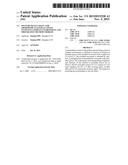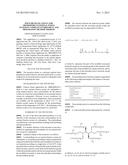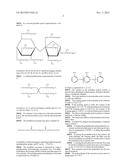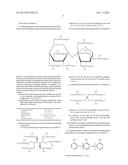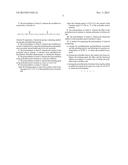Patent application title: POLYURETHANE USEFUL FOR ORTHOPEDICS EXTERNAL FIXING SYSTEM IN COMPLEX ENVIRONMENT AND PREPARATION METHOD THEREOF
Inventors:
Xieping Zhu (Shanghai, CN)
IPC8 Class: AC08G1876FI
USPC Class:
521110
Class name: Cellular products or processes of preparing a cellular product, e.g., foams, pores, channels, etc. cellular product formation prior to or during solid polymer formation in the presence of a stated ingredient other than water ingredient contains a silicon atom as part an organic compound
Publication date: 2015-11-05
Patent application number: 20150315328
Abstract:
A polyurethane used for orthopedics external fixing system in complex
environment is obtained by reaction of mixture of polyether polyol with
modified isocyanate in the weight ratio of 1:0.6-0.75. The modified
isocyanate is obtained by reaction of polyphenylene polymethylene
isocyanate with polyether glycol. The components and corresponding weight
percent amounts of the mixture of polyether polyol are as follows: 60-65%
polyether polyol; 0.3-1% catalyst; 0.1-2% foam stabilizer; 0.1-2% or
3-20% foaming agent; 25-40% filler and 0.5-2% functional auxiliary agent.
The method of producing the polyurethane is also provided.Claims:
1. A polyurethane for an external fixation system for orthopedics, the
polyurethane being a polyether polyurethane prepared by a polymerization
reaction using a polyether polyol mixture and a modified isocyanate as
raw materials, the polyether polyol mixture comprising a polyether
polyol, the polyether polyol comprising hydroxyl groups, the modified
isocyanate comprising isocyanate groups at terminals of a molecular chain
of the modified isocyanate, and the polymerization reaction being a
reaction between the hydroxyl groups and the isocyanate groups to form
urethane groups, wherein the polyether polyol mixture and the modified
isocyanate as raw materials in the polymerization reaction have a weight
ratio of 1:0.6-1:0.75; the polyether polyol mixture comprises ingredients
in the following weight percentages with respect to the polyether polyol
mixture:
TABLE-US-00002
the polyether polyol 60-65 wt. %,
a catalyst 0.3-1 wt. %,
a foam stabilizer 0.1-2 wt. %,
a foaming agent 0.1-2 wt. % or 3-20 wt. %,
a filler 25-40 wt. %, and
a functional additive 0.5-2 wt. %;
wherein the polyether polyol is selected from the following compounds: a) a first polyether polyol represented by a formula of ##STR00007## wherein a1, a2, a3, a4, a5, and a6 are integers, and a sum of a1, a2, a3, a4, a5, and a6 is from 7 to 15; b) a second polyether polyol represented by a formula of ##STR00008## wherein b1, b2, b3, b4, b5, b6, b7, and b8 are integers, and a sum of b1, b2, b3, b4, b5, b6, b7, and b8 is from 7 to 15; c) a third polyether polyol represented by a formula of ##STR00009## wherein c1, c2, c3, and c4 are integers, and a sum of c1, c2, c3, and c4 is from 7 to 15; or d) a mixture of more than one of the first polyether polyol, the second polyether polyol, and the third polyether polyol; and the modified isocyanate is prepared from polymerization reaction of a polyphenylene polymethylene isocyanate and polyether glycol.
2. The polyurethane of claim 1, wherein the polyphenylene polymethylene isocyanate is represented by a formula of ##STR00010## wherein n represents 0, 1, 2, or 3.
3. The polyurethane of claim 1, wherein the modified isocyanate has a formula of ##STR00011## wherein R represents a functional group containing methylene groups and phenylene groups.
4. The polyurethane of claim 1, wherein the modified isocyanate is prepared by using the polyphenylene polymethylene isocyanate and polyether glycol as raw materials.
5. The polyurethane of claim 1, wherein the catalyst in the polyether polyol mixture is selected from dimethylcyclohexylamine, dimethyl ethanolamine, or triethylene diamine.
6. The polyurethane of claim 1, wherein the foam stabilizer in the polyether polyol mixture is a silicone stabilizer.
7. The polyurethane of claim 1, wherein the foaming agent in the polyether polyol mixture is water or CH3CCl2F.
8. The polyurethane of claim 7, wherein when the foaming agent is water, the content of the foaming agent is 0.1-2 wt. % of the polyether polyol mixture; and when the foaming agent is CH3CCl2F, the content of the foaming agent is 3-20 wt. % of the polyether polyol mixture.
9. The polyurethane of claim 1, wherein the filler in the polyether polyol mixture is calcium carbonate or barium sulfate.
10. The polyurethane of claim 1, wherein the functional additive in the polyether polyol mixture is silica.
11. A method for preparing the polyurethane of claim 4, comprising: a) mixing the polyphenylene polymethylene isocyanate and the polyether glycol, and allowing for reaction at a temperature of 70-90.degree. C. to obtain the modified isocyanate; b) mixing the polyether polyol, the catalyst, the foam stabilizer, the foaming agent, the filler, and the functional additive according to a certain ratio to obtain the polyether polyol mixture; and c) mixing the polyether polyol mixture from step b) and the modified isocyanate from step a) at a ratio of 1:0.6-0.75 to obtain the polyurethane.
Description:
CROSS-REFERENCE TO RELATED APPLICATIONS
[0001] This application is a continuation-in-part of U.S. application Ser. No. 13/814,503, filed on Feb. 5, 2013, now pending, which is a National Stage Appl. filed under 35 USC 371 of International Patent Application No. PCT/CN2010/000785 with an international filing date of Jun. 2, 2010, designating the United States, and further claims priority benefits to Chinese Patent Application No. 200910052379.X filed Jun. 2, 2009. Inquiries from the public to applicants or assignees concerning this document or the related applications should be directed to: Matthias Scholl P.C., Attn.: Dr. Matthias Scholl Esq., 245 First Street, 18th Floor, Cambridge, Mass. 02142.
FIELD OF THE INVENTION
[0002] The invention relates to a polymer material and a preparation method thereof, and more particularly to a polyurethane for an external fixation system for orthopedics and a method for preparing the same.
BACKGROUND OF THE INVENTION
[0003] Chinese Patent Application No. 200810038254.7, titled as a new external fixation system for orthopedics, a using method thereof, and a polyurethane for the fixation system, has disclosed a polyurethane for an external fixation system for orthopedics. However, in poor conditions, for example, in the field at a low temperature, where no hospitals are available, and the temperature is about 5-15° C., the fixation system cannot be hardened by the polyurethane; whereas in the temperature of 25-30° C., the hardening of the fixation system is too fast and produces too much heat.
SUMMARY OF THE INVENTION
[0004] In view of the above-described problems, it is one objective of the invention to provide a polyurethane for an external fixation system for orthopedics. The polyurethane can effectively overcome problems resulting from hardening and heat production.
[0005] It is another objective of the invention to provide a method for preparing the polyurethane for an external fixation system for orthopedics.
[0006] Technical scheme of the invention is as follows:
[0007] A polyurethane for an external fixation system for orthopedics, is a polyether polyurethane which is prepared by using a polyether polyol mixture and a modified isocyanate as raw materials according to a weight ratio of 1:0.6-0.75. In the polymerization reaction of the polyether polyol and the modified isocyanate, reaction occurs between the hydroxyl groups within the polyether polyol and the isocyanate groups within the modified isocyanate to form the polyether polyurethane having urethane groups.
[0008] The reaction between the hydroxyl groups within the polyether polyol and the isocyanate groups within the modified isocyanate may be represented as follows:
##STR00001##
in which R1 represents the part of the modified isocyanate molecule except two isocyanate groups at the terminals of the molecular chain of the modified isocyanate molecule, and R2 represents the part of the polyether polyol molecule except two hydroxyl groups therein.
[0009] The polyether polyol mixture comprises ingredients in the following weight percentages with respect to the polyether polyol mixture:
TABLE-US-00001 the polyether polyol 60-65 wt. %, a catalyst 0.3-1 wt. %, a foam stabilizer 0.1-2 wt. %, a foaming agent 0.1-2 wt. % or 3-20 wt. %, a filler 25-40 wt. %, and a functional additive 0.5-2 wt. %.
[0010] The polyether polyol is selected from the following compounds:
[0011] a) a first polyether polyol represented by a formula of
##STR00002##
in which a1, a2, a3, a4, a5, and a6 are integers, and the sum of a1, a2, a3, a4, a5, and a6 is from 7 to 15;
[0012] b) a second polyether polyol represented by a formula of
##STR00003##
in which b1, b2, b3, b4, b5, b6, b7, and b8 are integers, and the sum of b1, b2, b3, b4, b5, b6, b7, and b8 is from 7 to 15;
[0013] c) a third polyether polyol represented by a formula of
##STR00004##
in which c1, c2, c3, and c4 are integers, and the sum of c1, c2, c3, and c4 is from 7 to 15; or
[0014] d) a mixture of more than one of the first polyether polyol, the second polyether polyol, and the third polyether polyol.
[0015] The modified isocyanate may have a formula of
##STR00005##
in which R is a functional group containing methylene groups and phenylene groups, and R' can be --CH2CH2--.
[0016] The modified isocyanate is prepared by using a polyphenylene polymethylene isocyanate (e.g., 4,4'-diphenylmethane diisocyanate (MDI)) and the polyether glycol as raw materials. The polyphenylene polymethylene isocyanate is represented by a formula of
##STR00006##
in which, n represents 0, 1, 2, or 3.
[0017] The catalyst in the polyether polyol mixture is selected from dimethylcyclohexylamine, dimethyl ethanolamine, or triethylene diamine.
[0018] The foam stabilizer in the polyether polyol mixture is a silicone stabilizer.
[0019] The foaming agent in the polyether polyol mixture is water or CH3CCl2F.
[0020] If the foaming agent is water, the content of the foaming agent is 0.1-2 wt. % of the polyether polyol mixture; and if the foaming agent is CH3CCl2F, the content of the foaming agent is 3-20 wt. % of the polyether polyol mixture.
[0021] The filler in the polyether polyol mixture is calcium carbonate, or barium sulfate.
[0022] The functional additive in the polyether polyol mixture is silica.
[0023] A method for prepare the polyurethane, comprises steps as follows:
[0024] a) mixing the polyphenylene polymethylene isocyanate and the polyether glycol, and allowing for reaction at a temperature of 70-90° C. to obtain the modified isocyanate;
[0025] b) mixing the polyether polyol, the catalyst, the foam stabilizer, the foaming agent, the filler, and the functional additive according to a certain ratio to obtain the polyether polyol mixture; and
[0026] c) mixing the polyether polyol mixture from step b) and the modified isocyanate from step a) according to a ratio of 1:0.6-0.75 to obtain the polyurethane.
[0027] Raw materials used in the preparation are all commercial products.
[0028] The polyurethane of the invention can be used at a temperature of 5-15° C.
[0029] The polyurethane of the invention can be used at a temperature of 25-30° C.
[0030] An optimal temperature for using the polyurethane of the invention is 21-25° C.
[0031] Advantages of the invention are summarized as follows:
[0032] The polyurethane of the invention can be used at a temperature of 5-15° C., and can fix fracture regions that are difficult to fix by plasters. The polyurethane has sufficient rigidity and intensity. X-ray can penetrate the polyurethane, so that the situation of the fracture region can be known. Besides, the polyurethane is sanitary and is convenient to expose the skin to oxygen; medical personnel can easily take off the polyurethane to clean and process the skin on the fracture region. Furthermore, the polyurethane has a much lower cost than metal stents, a much better fixation effect than polymer bandages or plasters, and does not result in infections or secondary hurts. Finally, when the polyurethane is attached to the skin, a temperature of a heat production is no higher than 38° C., and different shaping durations can be selected to avoid inducing cardiovascular diseases.
DETAILED DESCRIPTION OF THE EMBODIMENTS
[0033] To further illustrate the invention, experiments detailing a polyurethane and a method for preparing the same are described below. It should be noted that the following examples are intended to describe and not to limit the invention.
Example 1
[0034] Preparation of a modified isocyanate: a polyphenylene polymethylene isocyanate and a polyether glycol were mixed, and a reaction was carried out at a temperature of 70-90° C. to obtain the modified isocyanate.
[0035] Preparation of a polyether polyol mixture: 60 weight parts of a polyether polyol, 0.5 weight part of triethylene diamine, 1 weight part of a silicone stabilizer, 0.5 weight part of water, 37 weight parts of calcium carbonate, and 1 weight part of silica were collected and mixed to obtain the polyether polyol mixture.
[0036] Preparation of a polyurethane: the polyether polyol mixture and the modified isocyanate are mixed according to a ratio of 1:0.6 to obtain the polyurethane.
Example 2
[0037] Preparation of a modified isocyanate is the same as that of Example 1.
[0038] Preparation of a polyether polyol mixture: 61 weight parts of a polyether polyol, 1 weight part of triethylene diamine, 2 weight parts of a silicone stabilizer, 0.1 weight part of water, 35.4 weight parts of calcium carbonate, and 0.5 weight part of silica were collected and mixed to obtain the polyether polyol mixture.
[0039] Preparation of a polyurethane: the polyether polyol mixture and the modified isocyanate are mixed according to a ratio of 1:0.65 to obtain the polyurethane.
Example 3
[0040] Preparation of a modified isocyanate is the same as that of Example 1.
[0041] Preparation of a polyether polyol mixture: 62 weight parts of a polyether polyol, 0.3 weight part of triethylene diamine, 2 weight parts of a silicone stabilizer, 2 weight parts of water, 33 weight parts of calcium carbonate, and 0.7 weight part of silica were collected and mixed to obtain the polyether polyol mixture.
[0042] Preparation of a polyurethane: the polyether polyol mixture and the modified isocyanate are mixed according to a ratio of 1:0.65 to obtain the polyurethane.
Example 4
[0043] Preparation of a modified isocyanate is the same as that of Example 1.
[0044] Preparation of a polyether polyol mixture: 63 weight parts of a polyether polyol, 1 weight part of dimethyl ethanolamine, 0.5 weight part of a silicone stabilizer, 1 weight part of water, 33 weight parts of calcium carbonate, and 1.5 weight parts of silica were collected and mixed to obtain the polyether polyol mixture.
[0045] Preparation of a polyurethane: the polyether polyol mixture and the modified isocyanate are mixed according to a ratio of 1:0.7 to obtain the polyurethane.
Example 5
[0046] Preparation of a modified isocyanate is the same as that of Example 1.
[0047] Preparation of a polyether polyol mixture: 64 weight parts of a polyether polyol, 0.5 weight part of dimethylcyclohexylamine, 1.5 weight parts of a silicone stabilizer, 7 weight parts of CH3CCl2F, 25 weight parts of barium sulfate, and 2 weight parts of silica were collected and mixed to obtain the polyether polyol mixture.
[0048] Preparation of a polyurethane: the polyether polyol mixture and the modified isocyanate are mixed according to a ratio of 1:0.75 to obtain the polyurethane.
Example 6
[0049] Preparation of a modified isocyanate is the same as that of Example 1.
[0050] Preparation of a polyether polyol mixture: 65 weight parts of a polyether polyol, 1 weight part of dimethylcyclohexylamine, 1.2 weight parts of a silicone stabilizer, 1 weight part of water, 30 weight parts of barium sulfate, and 1.8 weight parts of silica were collected and mixed to obtain the polyether polyol mixture.
[0051] Preparation of a polyurethane: the polyether polyol mixture and the modified isocyanate are mixed according to a ratio of 1:0.63 to obtain the polyurethane.
Example 7
[0052] Preparation of a modified isocyanate is the same as that of Example 1.
[0053] Preparation of a polyether polyol mixture: 60 weight parts of a polyether polyol, 0.3 weight part of dimethylcyclohexylamine, 0.2 weight part of a silicone stabilizer, 14 weight parts of CH3CCl2F, 25 weight parts of barium sulfate, and 0.5 weight part of silica were collected and mixed to obtain the polyether polyol mixture.
[0054] Preparation of a polyurethane: the polyether polyol mixture and the modified isocyanate are mixed according to a ratio of 1:0.68 to obtain the polyurethane.
User Contributions:
Comment about this patent or add new information about this topic:

